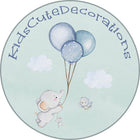Watercolor – the artistic technique that I use to design wall decorations for children's rooms
In the description of my wall stickers, posters for kids or baby birth stats prints, I often use terms such as "watercolor technique" or "painted with watercolor paints". In this blog post I will try to introduce you this painting technique more closely.
Personally, I love learning about different painting styles and techniques, and also to experiment with them. In case of my art design I use acrylic and oil paints. I'm also familiar with the secrets of egg tempera (this technique is used, for example, when writing icons). However watercolor paints remain my favourite.

What is watercolor?
Watercolor paints are water-based, which means they are diluted in water. They consist of a pigment (i.e. a color) and a binder (like a gum arabic). Painting with water paints is one of the oldest painting techniques known since antiquity.
What is the characteristics of watercolor?
What is special about painting with watercolor paints is their transparency (that is the more water you add, the more diluted and transparent the paint becomes) and vivid and dynamic nature. What captivates me most about this technique is their delicacy and airiness.
Watercolor has the opinion of "difficult" because it does not allow any corrections or adjustments, and moreover, it cannot be repainted, as is possible with acrylic or oil paints. Watercolor can be unpredictable and capricious, and the biggest challenge in this technique is controlling and adding the right amount of water. For me personally, watercolor is a wonderful medium and a great fun and an opportunity to experiment (you can add salt, Chinese inks, combine with crayons, etc.).
Types of watercolor paints
Watercolor paints are available in tubes or cubes. Personally, I use cubed ones because they are more comfortable for me to work with. In addition, many companies offer paints in separate cubes and not only in sets, so I can freely create my own color palette from them. Paints in tubes will work better when you want to paint larger surfaces (for example, the background).
Watercolor paper and brushes
Paper is one of the most important elements when painting with watercolor. It has a huge impact on the interaction of colors. It cannot be ordinary paper such as for sketches or acrylics. In this painting technique we use a lot of water, so ordinary paper will wrinkle and distort. Special papers with a high basis weight of at least 300 grams are dedicated to the watercolor painting.

For me, the cotton paper from Canson-Heritage or Arches with a basis weight of 300 grams is ideal. I use already gummed paper, which means that all sides of the paper are glued together. This is very useful when painting, because there is no need to soak the paper and tape it to a harder surface.
The watercolor paper can have different textures, such as fine-grained, coarse-grained and satin (with a perfectly smooth surface). When it comes to texture, I don't think any paper is better than the other. It's simply a matter of taste and individual choice of each artist.
Watercolor brushes are as important as paper. Brushes can be made of natural hair of various animals (e.g. squirrels, sable or marten) or synthetic, which absorb less water, so it is easier to control them when painting.
Basic techniques in the watercolor painting
The watercolor painting is a wealth of different techniques and methods. The more experienced the artist, the more techniques she uses in her works. Here I will introduce you to the following two basic watercolor techniques:
1. "Wet on wet" technique
This technique consists in soaking or moistening the paper (whole or a fragment) and applying paint to the paper with a wet brush. This method allows for smooth and even transitions. In this way, you can paint, for example, the background or the sky. In this technique, it is more difficult to control the flow of paint, which can give us various surprises. Nevertheless, this unpredictability can also be a great advantage for some people.

2. "Wet on dry" technique
This technique consists in painting with a damp brush on dry paper. The technique allows for greater control over the paint and water while painting. This is the method I use most often for my art works when painting cute animals or other cute characters that I use to design my products for children, such as kid's room wall stickers, posters for a children's room or new baby birth stats prints.

